Dazzling, exotic, and often expensive, there are so many types of saltwater Angelfish that it’s hard to get to know them all!
Angelfish are often instantly recognizable as they manage to find a place in nearly any saltwater aquarium.
If you’re looking to choose the right type of saltwater angelfish, have a look at my summary below!
About Saltwater Angelfish
Angelfish are grouped in the family Pomacanthidae. Nearly all are found on shallow, tropical reefs in the Atlantic, Western Pacific, and Indian Oceans.
Angelfish are some of the most iconic types of saltwater fish. Their vivid colorations are the epitome of what it means to be a reef fish. Many species also completely transform in color as they mature from juvenile to adulthood.
When young, saltwater Angelfish can even act as cleaner fish on the reef, nibbling parasites off from the skin of larger fish. They will choose an obvious perch and wait for large Wrasses, Parrotfish, and even predators like Groupers and Sharks.
Currently there are 88 species of saltwater Angelfish, from the dwarf Centropyge species to the larger Holacanthus and Pomacanthus, many of which can reach up to 20 inches in length.
Saltwater Angelfish often have specialized feeding habits that make them difficult aquarium residents. Some eat mostly filamentous algae while others prefer benthic invertebrates like sponges, hydroids, and bryozoans.
Their odd diets can make them especially challenging to keep in aquaria, though specialized frozen saltwater Angelfish preparations make life easier. Because Angelfish love to graze they are usually not reef-safe. However a few select types can be attempted with caution and are mentioned below. The Genicanthus genus of Angelfish are an exception and are entirely reef safe.
Types of Saltwater Angelfish
Here are a few types of saltwater Angelfish that you can keep at home:
Flame Angelfish
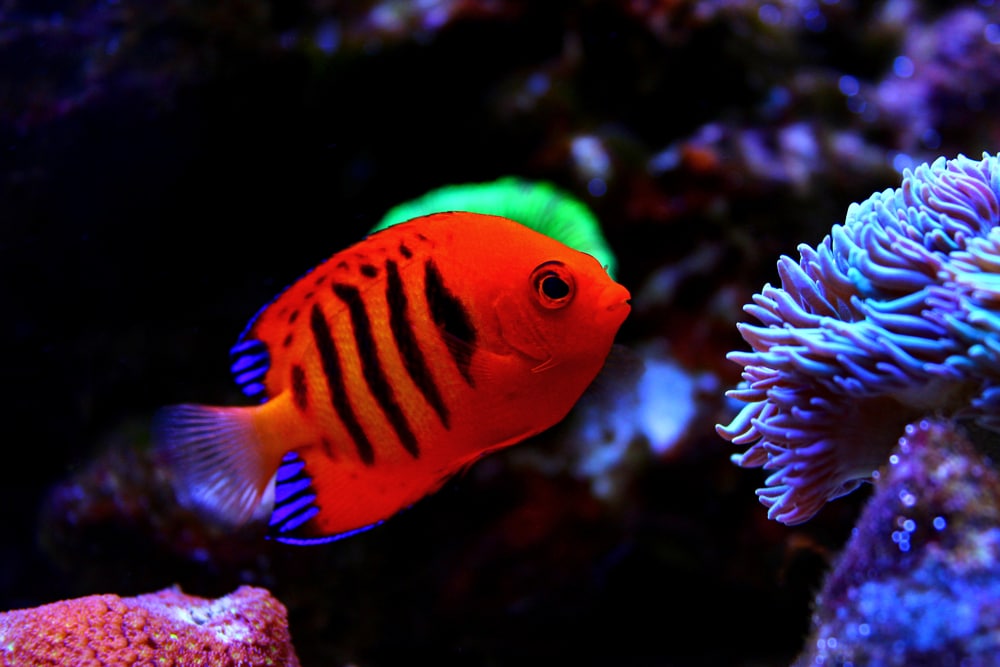
The Flame Angelfish is easily one of the most popular types of Angelfish. And for good reason; its intense red coloration contrasts beautifully with the black bars and blue flecks on its rear fins.
They vary slightly, depending on the source; Hawaiian and Tahitian Flame Angelfish are more intensely red throughout, and are more expensive. On the other hand, Indo-Pacific Angelfish usually have a yellow-orange core or are entirely orange.
Flame Angelfish should be introduced into established tanks, especially if wild caught. However, they are hardy fish and aren’t picky eaters. They should be given a mix of high quality vegetable and meaty items like spirulina flakes and brine shrimp for optimal health and color.
Flame Angelfish are also excellent community dwellers and are rarely aggressive towards tankmates.
- Scientific Name: Centropyge loriculus
- Price: $45-$155
- Size: 3 to 4 inches
- Difficulty: Easy
Potter’s Pygmy Angelfish
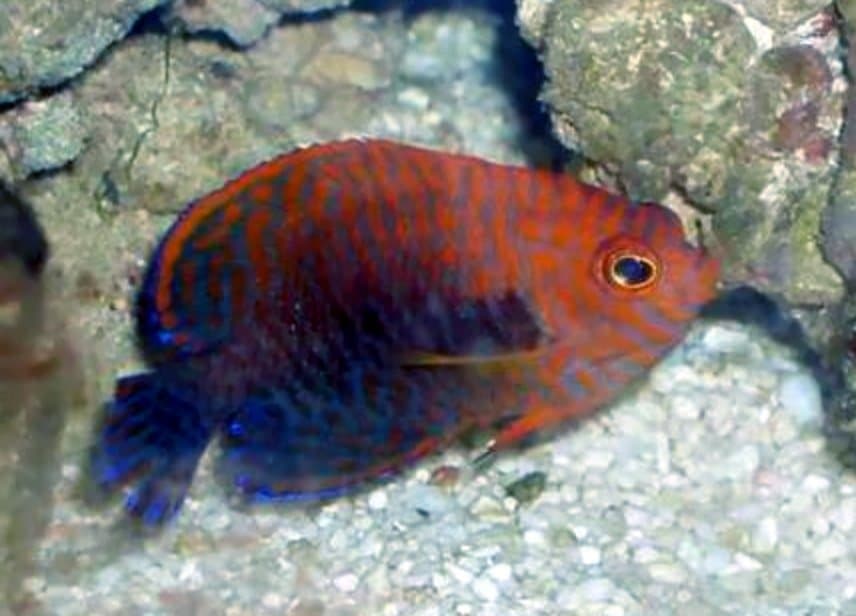
Potter’s Pygmy Angelfish are found exclusively in the Hawaiian Islands, which makes them fairly expensive relative to similar sized marine fish. As one of the larger types of Pygmy Angelfish, Potter’s can reach up to 5 inches long. They mostly graze on filamentous algae in the wild and are considered reef safe.
However, they are occasionally known to sample mucus from soft corals and clam mantles; keep a close eye on them if you intend on adding one to your reef aquarium. Potter’s Pygmy Angelfish are also semi-aggressive and should be the last fish introduced in order to allow their tankmates time to adjust.
While mostly wild caught, Potter’s Pygmy Angelfish adjust readily to captivity and accept a wide range of food items. Vegetable based foods should be the basis of their diet, however.
- Scientific Name: Centropyge potteri
- Price: $75-$125
- Size: 4 to 5 inches
- Difficulty: Easy
Keyhole Angelfish
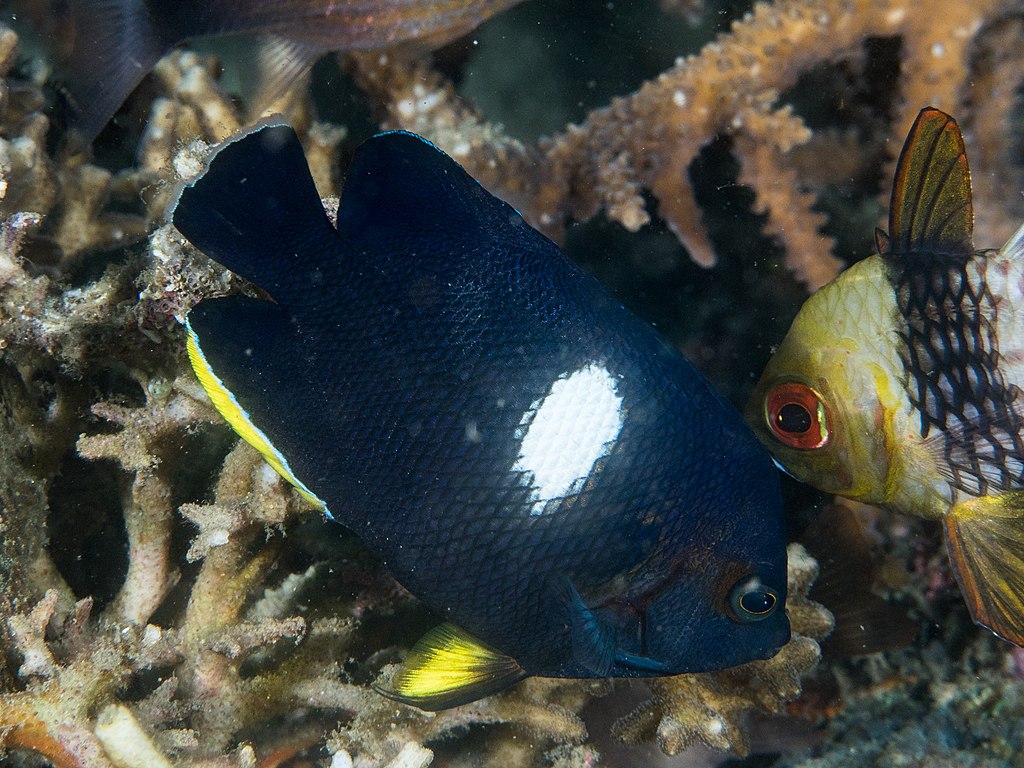
Also known as the Tibicen or Melas Angel, Keyhole Angelfish are one of the larger Centropyge species and are widespread throughout the tropical Indo-Pacific. They have a subdued color compared to their cousins, with a blue-black body and a single white spot that earns them their common name. Keyhole Angelfish are also somewhat aggressive and will chase similarly sized and shaped fish, including other Angelfish.
Keyhole Angelfish are not reef-safe, unfortunately, and will happily munch on Corals, Christmas Tree worms, and other reef organisms. They do better in fish plus live rock aquariums. On the other hand, this means Keyhole Angelfish are not picky when it comes to feeding and will take a wide variety of food offerings.
- Scientific Name: Centropyge tibicen
- Price: $25-$45
- Size: Up to 6 inches
- Difficulty: Easy
Bicolor Angelfish
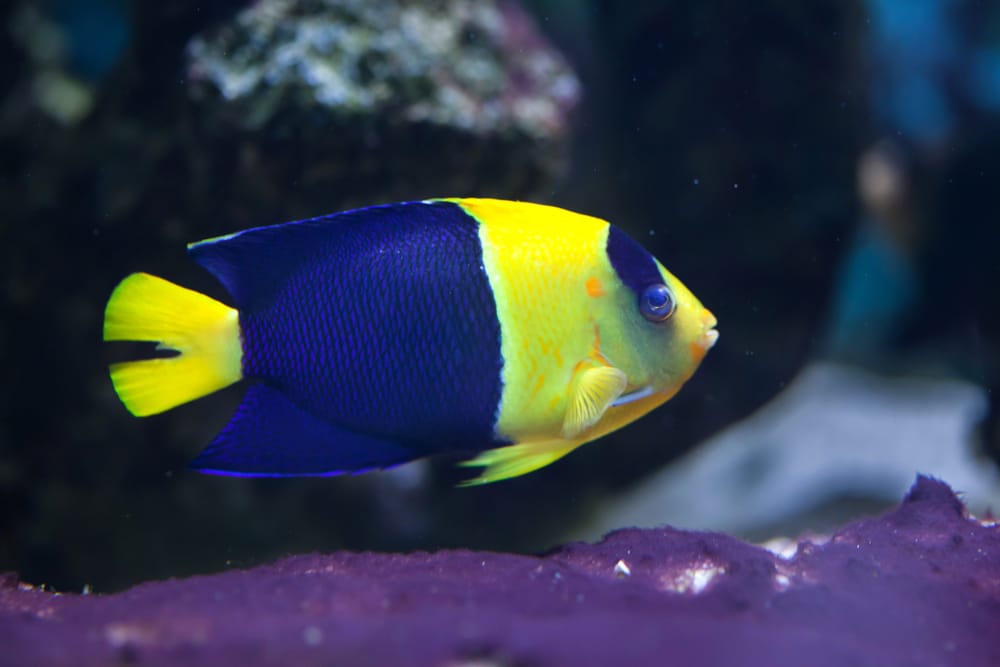
Bicolor Angelfish are found across an incredibly wide swath of territory, from East Africa all the way to the Line Islands in the Central Pacific Ocean. They are shallow water reef dwellers with omnivorous manners. This makes them unsuitable for reef aquariums but excellent show specimens for medium to large community tanks.
Like most larger types of Angelfish, Bicolors are territorial and semi-aggressive, particularly towards each other. In fact, captive breeding is almost impossible, even in large aquaria, because they form especially large territories in nature.
Bicolor Angelfish are often sensitive and can be stressed and even killed by moderate fluctuations in water quality and parameters. While common in the trade and fairly inexpensive, they are best added last to well established tanks.
- Scientific Name: Centropyge Bicolor
- Price: $20-40
- Size: Up to 6 inches
- Difficulty: Moderate
Lemonpeel Angelfish
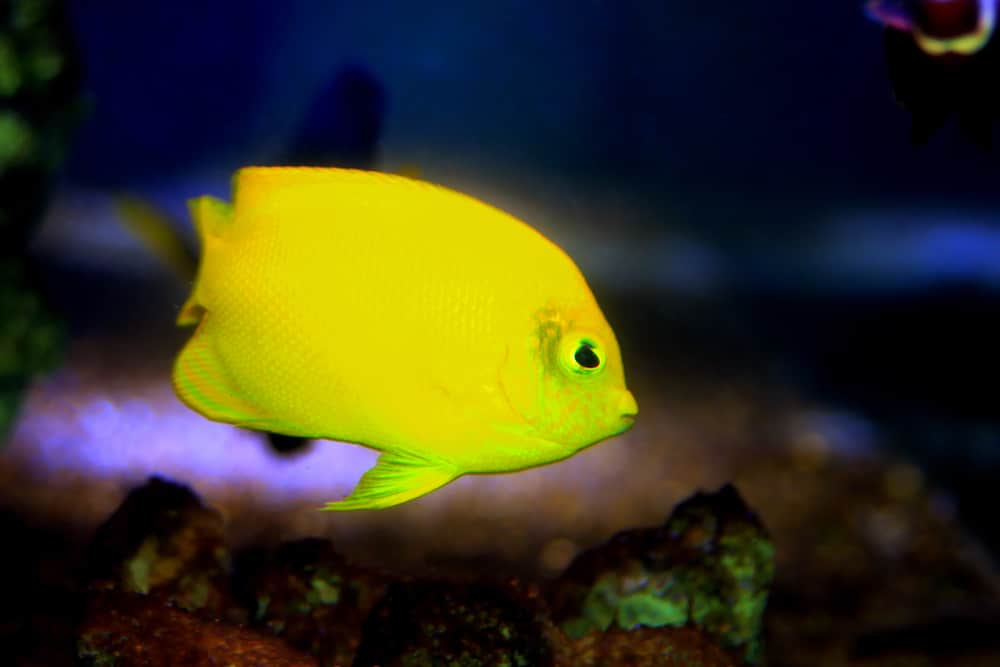
Lemonpeel Angelfish are widespread throughout the Western Pacific Ocean, from Japan to Indonesia, and throughout atolls and archipelagos in the Central Pacific. As one of the more aggressive types of Angelfish, Lemonpeels should be introduced last. They are also more sensitive, like Bicolor Angelfish, and a mature aquarium ecosystem goes a long way towards keeping them healthy.
Lemonpeel Angelfish are also not reef safe; as grazers they eat mostly algae in nature but will greedily pick at corals, clams, sponges, and other benthic invertebrates. They should also never be kept with other Angelfish as they will chase and harass their cousins to death if they can.
- Scientific Name: Centropyge flavissima
- Price: $45-75
- Size: 5 inches
- Difficulty: Moderate
Black Nox Angelfish
While it doesn’t have the flaring rainbow colors of its cousins the Black Nox Angelfish is nevertheless a reef beauty, with an intense midnight black color that persists to adulthood. Black Nox Angelfish are average sized for Centropyge and are also one of the most peaceful of the genus.
Black Nox Angelfish can be kept with other more peaceful Centropyge and can even be kept with their own kind in tanks at least 100 gallons in size. They are not reef safe, however, and should be kept in fish-only community aquariums. They aren’t picky eaters, however, and will devour both vegetable and meat based offerings with relish.
- Scientific Name: Centropyge nox
- Price: $20-$30
- Size: 4 inches
- Difficulty: Easy
Peppermint Angelfish
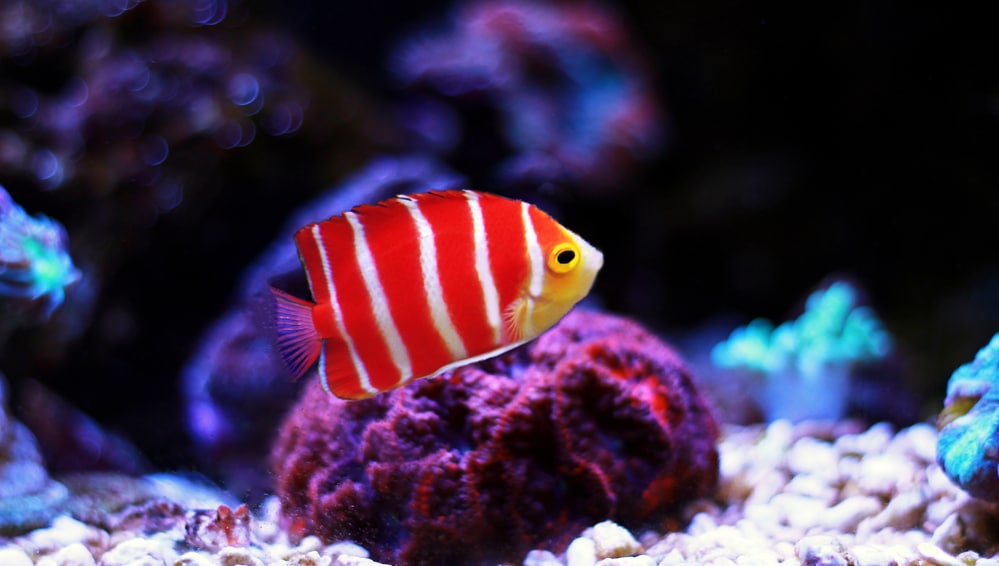
Peppermint Angelfish are famous for being one of the most expensive fish in the aquarium trade. While specimens can occasionally be found for “only” $1000, a single Angelfish once sold for $30,000!
Peppermint Angelfish are difficult to find and keep due to their habitat. They are found exclusively in deep water around the Cook islands and Rarotonga, from 50m down to 100m. This makes diving not only a challenge but bringing them back to the surface as they can die from decompression if brought up too rapidly.
Peppermint Angelfish are found in deep, poorly lit conditions and colder water temperatures compared to other Angelfish (60-70F). If these conditions aren’t met, they often perish.
- Scientific Name: Centropyge boylei
- Price: $800-$30,000
- Size: 4 inches
- Difficulty: Difficult
Queen Angelfish
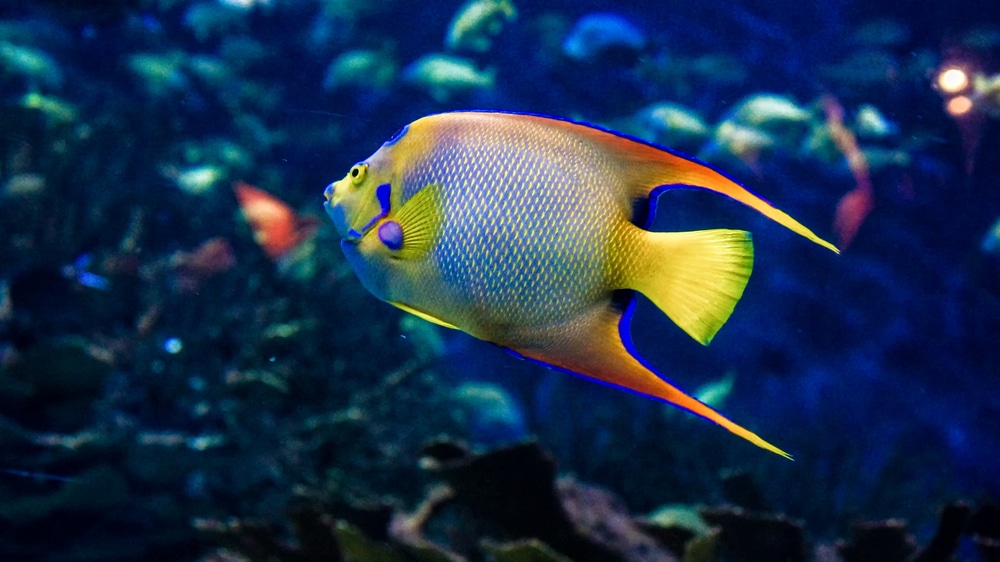
Queen Angelfish are one of the largest species and are found in tropical waters throughout the Western Atlantic Ocean. Unlike the Centropyge Angelfish of the Pacific, Holocanthus species feed almost exclusively on sponges, with the occasional jellyfish, coral, and algae thrown in for flavor. Fortunately, frozen prepared Angelfish foods can be found at speciality aquarium shops – San Francisco Bay and Hikari make the most popular formulae.
While not especially sensitive to water conditions Queen Angelfish are challenging due to their immense size and diet. They can reach up to 20 inches and 4 lbs in weight, making at least 180 gallons of space essential. Queen Angelfish will chase other types of Angelfish in tanks smaller than 250 gallons.
- Scientific Name: Holacanthus ciliaris
- Price: $50-200
- Size: 15-20 inches
- Difficulty: Difficult
Emperor Angelfish
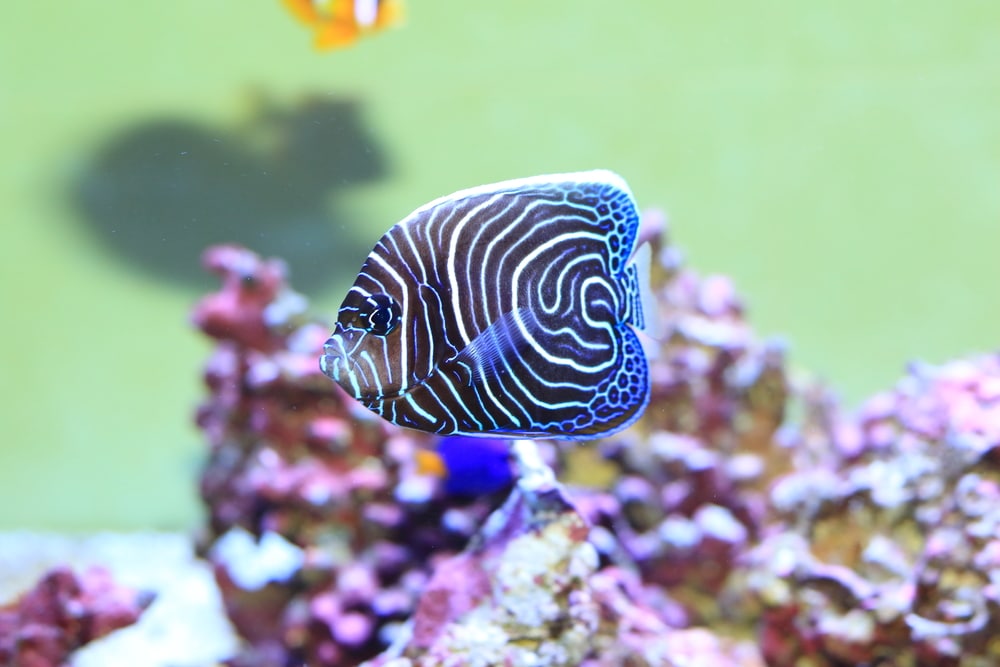
Emperor Angelfish are found in a wide swath of the Indo-Pacific, from East Africa and the Red Sea all the way to the Central Pacific. The young are marbled in black, blue, and white swirls and only become more beautiful as they age. By 3 years of age they transform fully, with bold yellow and blue stripes accenting a black mask.
While Emperor Angelfish are sponge feeders they are more omnivorous and will also accept vegetable and carnivorous preparations as well. They are semi-aggressive, however they may pair off if raised together or are given an especially spacious tank. In the wild Emperor Angelfish even form trios of a male to two females that patrol a territory.
- Scientific Name: Pomacanthus imperator
- Price: $60-$150
- Size: 16 inches
- Difficulty: Moderate
French Angelfish
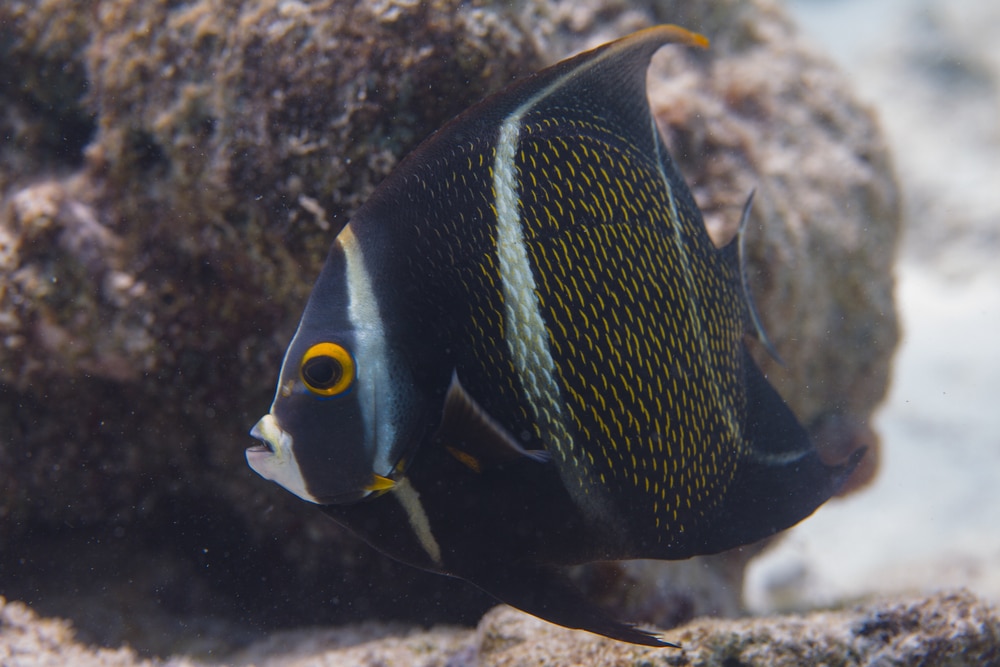
French Angelfish are a strikingly patterned type of Angelfish; as juveniles they have a bold black body with yellow stripes. As they mature, the face turns grey and the black remains. However, the yellow migrates to form golden highlights on each scale.
French Angelfish are found throughout the Western Atlantic and are one of the more peaceful types of Angelfish. They can even be kept with other Angelfish so long as the tank is spacious enough (300+ gallons).
While the majority of their diet consists of sponges, bryozoans, and other sessile organisms, French Angelfish also consume a fair amount of algae and occasionally small invertebrates. Thus, marine Angelfish sponge preparations can be a smaller portion of their diet.
French Angelfish are also hardy and less disease prone than their cousins, making them an ideal first large Angelfish.
- Scientific Name: Pomacanthus paru
- Price: $150-200
- Size: Up to 18 inches
- Difficulty: Easy
Regal Angelfish
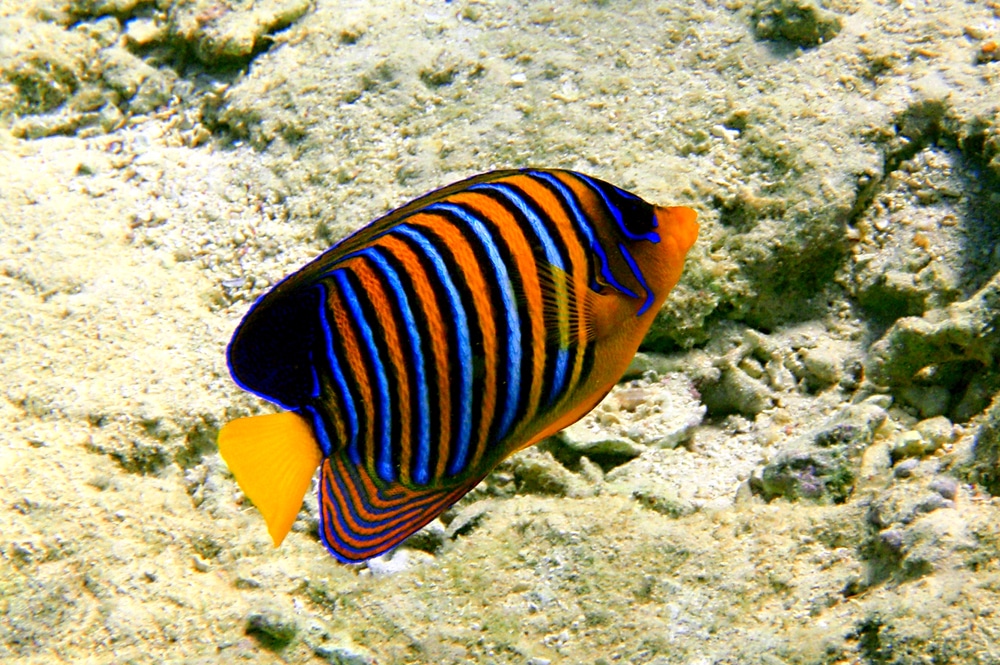
Regal Angelfish are especially beautiful but unfortunately, especially challenging to keep. They rarely adapt well to captive life and are susceptible to infections, stress from water parameter fluctuation, and bullying from tankmates.
Regal Angelfish should be kept exclusively with peaceful fish – which they will then bully once they establish a territory. Unfortunately, keeping these bullies with other semi-aggressive fish can stress them to death.
They are mostly sponge feeders and should be fed a frozen marine Angelfish prepared diet, mixed with meaty and vegetarian foods. While all Angelfish are risky reef inhabitants, Regal Angelfish are some of the least likely to bother corals.
When first purchased, a quarantine period for observation and bulking up is a good idea in order to keep the Regal from feeling intimidated by its tankmates. If kept in a stable setting with ample hiding places and non-threatening tank mates, Regal Angelfish can live for over a decade.
- Scientific Name: Pygoplites diacanthus
- Price: $75-150
- Size: 8 to 10 inches
- Difficulty: Difficult
Gold Flake Angelfish
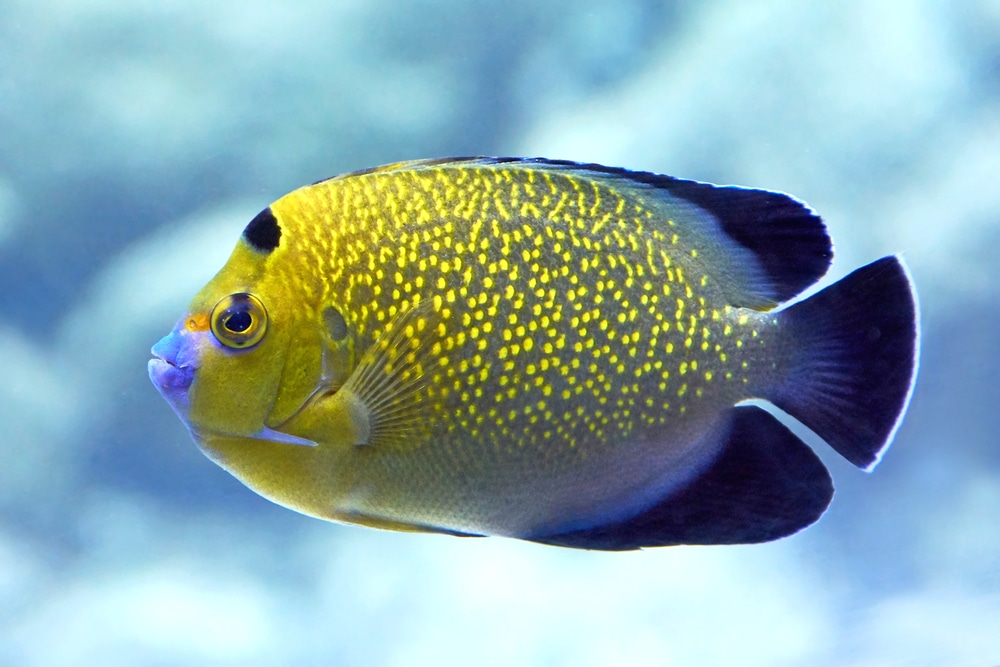
Gold Flake Angelfish are relatively rare in the hobby and are found around scattered atolls in the Central and Western Pacific. They command a very high price; even 2-3 inch juveniles cost hundreds of dollars.
Most of the Angelfish in the genus Apolemichthys are relatively hardy and the Gold Flake Angelfish is no exception. Algae forms a large part of their diet, with sponges, bryozoans, and other tunicates forming a smaller portion compared to other large Angelfish.
Whether they are reef safe is something of a debate; many aquarists report that as juveniles they are fine, only to become terrors to coral as adults. Others insist that Gold Flake Angelfish are model reef inhabitants.
- Scientific Name: Apolemichthys xanthopunctatus
- Price: $500-750
- Size: 8 to 10 inches
- Difficulty: Moderate
Lamarck’s Angelfish
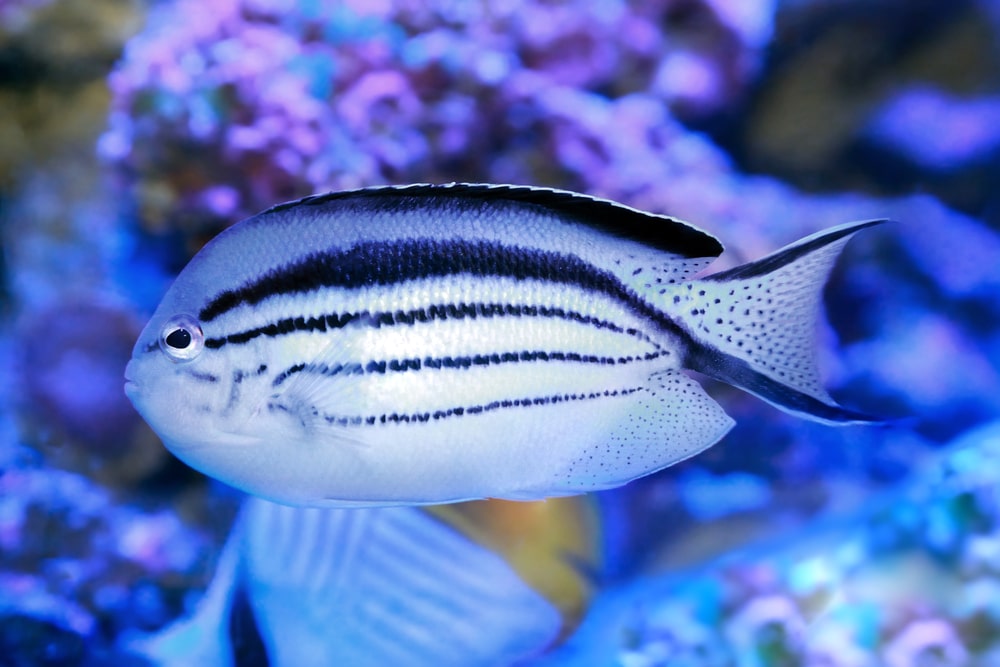
Genicanthus Angelfish are some of the most unique types of Angelfish. They are planktivores, consuming small suspended organisms from the water column rather than grazing on reefs.
Genicanthus are easy to feed and will accept most prepared and frozen food offerings. They are also entirely reef safe as they won’t bother corals, clams, and other benthic invertebrates.
Lamarck’s Angelfish, like all Genicanthus, are also sexually dimorphic; the male is not only larger but has black pelvic fins and a distinctive yellow spot on the forehead. Lamarck’s Angelfish is also peaceful and can be kept in groups with one male and several females.
If you accidentally get two males, after some fighting the subordinate will eventually change sex and become a female!
- Scientific Name: Genicanthus lamarck
- Price: $30-60
- Size: 8 to 10 inches
- Difficulty: Easy
Blue-Girdled Angelfish
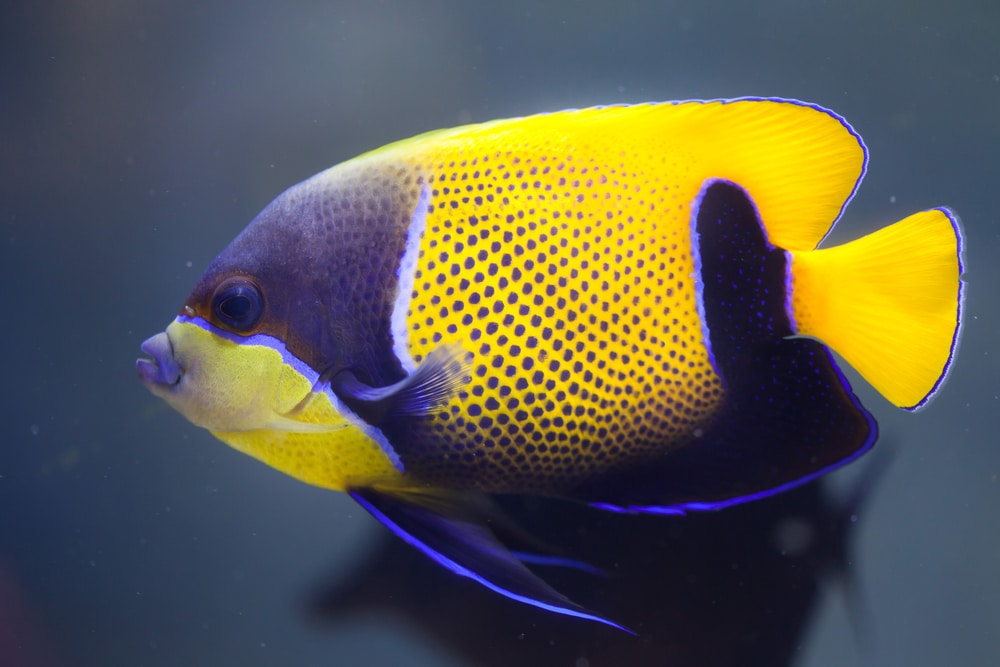
Also known as the Majestic Angelfish, Blue-Girdled Angelfish are a medium sized, relatively shy species found across the Indo-Pacific. While they are semi-aggressive towards similarly sized Angelfish they can be kept with Dwarf Angelfish and tend to ignore other fish.
Blue-Girdled Angelfish are one of the few large Angelfish that are potentially reef-safe. When well fed with sponge preparations and a mixture of vegetable and meaty foods, they rarely bother noxious soft and small polyped stony corals.
However, it’s always a gamble keeping Angelfish in a reef aquarium because they are natural grazers who will eventually want to sample everything in the tank at least once.
- Scientific Name: Pomacanthus navarchus
- Price: $100-250
- Size: 10 to 14 inches
- Difficulty:
Rock Beauty Angelfish
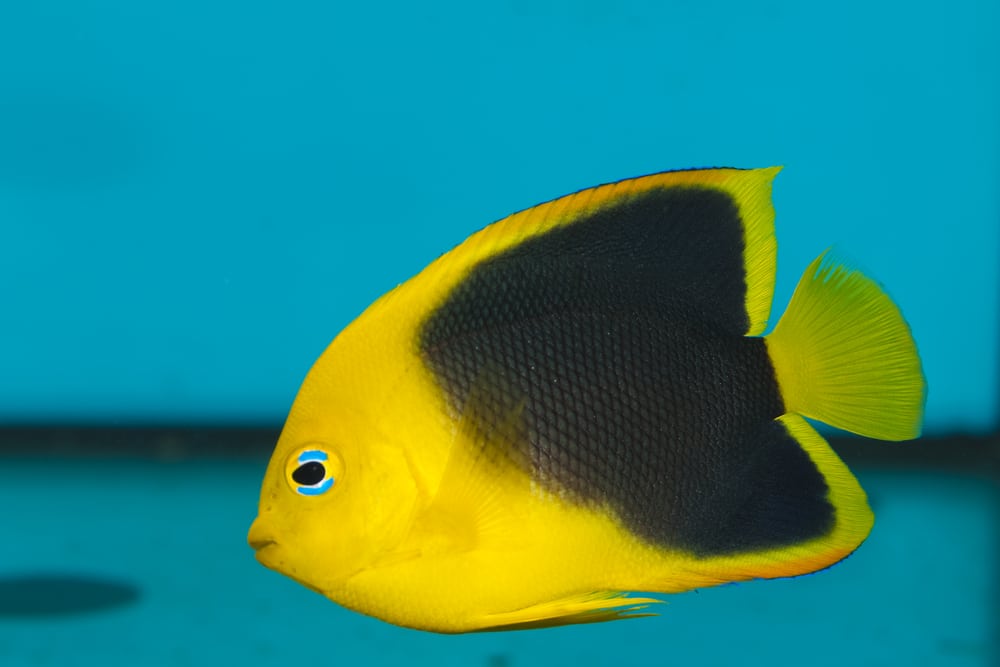
Like their close cousin the Queen Angelfish, Rock Beauty Angelfish are almost exclusively sponge feeders, making a large stock of frozen marine Angelfish preparation essential for keeping them.
Besides their diet, Rock Beauty Angelfish are hardy and easy to care for. Found in the Western Atlantic from Brazil up to the Gulf of Mexico, they are an inexpensive large Angelfish and boldly colored.
Choosing tank mates can be a challenge because while Rock Beauty Angelfish are semi-aggressive they stress easily when bullied. Tangs, Wrasses, and peaceful yet swiftly moving fish make ideal companions for a Rock Beauty.
- Scientific Name: Holacanthus tricolor
- Price: $20-50
- Size: 10 inches
- Difficulty: Moderate

